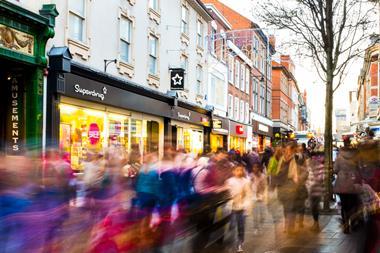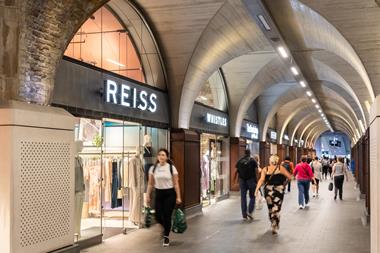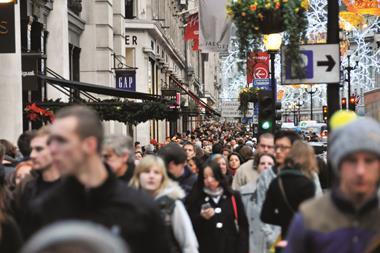Buying behaviour has changed. Oli Freestone, head of institute at Capita, discusses some of the big shifts and what they mean for retailers looking to win market share.
Retail has always been a cyclical industry, shaped by shifting markets and evolving patterns of behaviour.
As a result, it’s had to reinvent itself on several occasions, for example by shifting from local market trading to the high street and then to out-of-town centres, as well as the emergence of the first supermarkets, through to today’s online giants and more recently the birth of direct-to-consumer brands and influencer business models.
It’s plain to see that retail is experiencing extreme turbulence.
Rising cost pressures, especially for those with physical store networks, the threat of new entrants going direct to consumers and the accelerated pace of technology and shifting customer behaviours are all factors attacking existing operating models. All this means that, for many, standing still ultimately means going backwards.
Shifting customer behaviour
As the balance of power has flipped from retailer to consumer over the past two decades, those who have not kept their finger on the pulse have fallen by the wayside as customers demand greater choice, more channels and improved convenience.
“Whereas once shoppers may have accepted mediocre, their ability to go elsewhere at the swipe of a finger has meant the best have captured more share of wallet”
It is no longer acceptable, for example, to provide an 8am to 6pm home-delivery window (although many still do!) or to not have a detailed understanding of customer contact and context across all channels.
Whereas once shoppers may have accepted mediocre, their ability to go elsewhere at the swipe of a finger has meant the best have captured more share of wallet, while the rest have seen their returns diminish.
The pace of inflating expectations is frightening and, as a result, retailers are having to continually invest in their propositions and supporting operations or risk slipping behind.
Many have championed innovation as a silver bullet, but, without digging deeper into some of the fundamental changes in shopper behaviour, these types of initiatives run the risk of being nothing more than theatre.
Here we highlight three big trends in customer behaviour that retailers should consider:
1. Bifurcation of decision-making
Decision-making has become much more complex for items with high involvement (e.g. infrequent, riskier, higher price points), while simultaneously more ‘automated’ for lower involvement purchases (e.g. routine, more commoditised, lower price points).
Products and services with high involvement, such as luxury goods or insurance, increasingly involve a complex latticework of channels and feedback loops during research, consideration and decision-making.
We’ve seen the traditional decision-making journey move away from a ‘funnel’, in which options are surfaced early and then systematically narrowed down to a single decision in a methodical manner, to a process that is far more cyclical and complex.
This is due to the explosion of choice, meaning that customers are faced with a paralysing array of options.
“We’ve seen the traditional decision-making journey move away from a ‘funnel’ to a process that is far more cyclical and complex”
Psychologist Barry Schwartz has championed the idea of the paradox of choice for more than 15 years, and that idea is still relevant as a host of new sources of information create anxiety for the customer at each stage of decision-making.
As a result, retailers need to be better equipped to support customers in making decisions that reflect this challenge.
Previously, a consumer may have started off with an idea of the product in mind, researched options and prices, and then made a decision in-store. Nowadays, they are far more likely to start with a rough idea, research online and, as a result, either expand the decision set or alter it altogether as new ranges and options are presented.
Further interactions across social media may change that view again, while well-timed, targeted messaging, Black Friday offers or a recommendation from a friend can take a consumer down another path.
In the case of lower-involvement purchases, one-click shopping and subscription models have taken decision-making out of the equation and made repeat purchasing of staples practically frictionless.
In this scenario, if a retailer is not front-of-mind very early on, there is a risk of them being disregarded not only for the first purchase, but potentially for a significant period of repeat purchases as fewer consumers opt to spend time serendipitously exploring options.
2. The sale is just the start
While the proliferation of channels and products requires retailers to find new ways to get their products and services included in the initial consideration set, it’s arguably just the beginning of the hard work.
After a sale, the post-purchase experience shapes the customer’s opinion for every subsequent decision in the category and how well they in turn might ’remarket’ a retailer via their own network of friends and followers.
The digitally savvy continue to outperform the market in this post-purchase stage, with the more successful providing ever better services in order to increase the chances of return visits and repeat buys.
These retailers are far more adept at using insights to retarget and personalise offers, and have a better understanding of the lifetime value of their customers by investing in tools such as social sentiment analytics and conversational commerce to drive closer relationships.
Retailers need to think about what happens after the sale to ensure involvement in the next one.
3. Promiscuity is on the rise
Various marketing gurus have declared that loyalty is dead. While the customer is definitely more in control than ever before, this statement seems a tad hasty. Strong brands still command loyalty, and excellent service will bring a customer back.
However, retailers are having to work harder and harder because of factors such as the explosion of choice, the complexity of decision-making and the pace at which expectations are moving.
“Loyalty isn’t dead, but promiscuity is on the rise: a well-timed offer or message could be the killer intervention required to make a customer trial an alternative”
As a result, loyalty isn’t dead, but promiscuity is on the rise: a well-timed offer or message could be the killer intervention required to make a customer trial an alternative.
In order to do this, retailers must understand the various stages of decision-making, the channels used and the right time to intervene. This requires deep insights and the tools to take real-time decisions.
Savvy retailers are putting more resources into setting up customer experience centres, which are more akin to ’mission control’ facilities, whereby masses of data are continually analysed across channels to understand where service breakdowns and opportunities are occurring.
These are just three behavioural trends we’re seeing disrupting the way customers are buying today.
The balance of power may have swung over to the customer, but retailers have the opportunity to disrupt back.

Oli Freestone leads the Capita Institute, providing digital thought leadership, research and insights
He has worked across multiple industries as a management consultant and has expertise in strategy, technology and innovation. He is a regular contributor to leading publications on these topics.
Hear what Capita’s customer experience experts Jo Weigh and Charlie Whitworth have to say on how retailers can turn a seamless experience into a sales drive here.

































